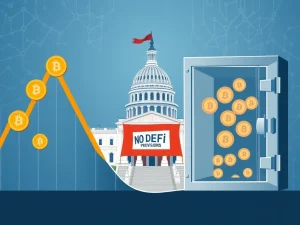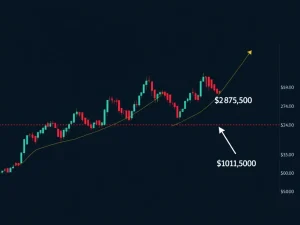Unveiling the Failures: Why Most Blockchain Cities Crumble

The promise of **blockchain cities** has long captivated innovators and idealists alike. Imagine a world where code governs, transactions are transparent, and communities thrive on decentralized principles. However, the journey to establish these utopian **crypto city projects** has been fraught with challenges. Many ambitious ventures have faltered, unable to overcome the complex interplay of regulations, funding issues, and the sheer scale of urban development. This article explores the common pitfalls that have led to the demise of numerous blockchain-powered urban dreams, while also highlighting a rare success story.
The Lofty Ambitions of Blockchain Cities
For several years, the blockchain industry envisioned its own ‘city on a hill.’ These idealistic communities aimed for a foundation built on blockchain technology. Code would serve as the law, creating transparent and efficient systems. Many projects, however, did not always succeed. Regulations, unrealistic expectations, and other factors often made them dead on arrival.
Founders have strived to build communities on blockchain. Some projects were more grounded, using blockchain for land registry. Others sought to build entire cities running solely on blockchain and crypto. A recent example, though controversial, is former US President Donald Trump’s alleged plan for a ‘Gaza Riviera.’ This plan incorporated a token into its fundraising and property investment model.
Artist’s interpretation of the Gaza Reconstitution, Economic Acceleration and Transformation Trust. Source: The Washington PostMS Satoshi: A Seasteading Crypto City Project Sinks
Eccentrics have long pursued a freer life at sea. Pirates, French actor Gérard Depardieu, and Scientology founder L. Ron Hubbard exemplify this desire. In October 2020, three Bitcoin (BTC) idealists, Grant Romundt, Rüdiger Koch, and Chad Elwartowski, purchased the Pacific Dawn. This 245-meter cruise ship cost $9.5 million. They aimed to convert it into a **crypto city project** docked off Panama.
The MS Satoshi was designed as an inclusive community. It targeted digital nomads and Bitcoin adopters. The project combined crypto enthusiasts with the ‘seasteading’ movement. This movement, born among tech executives, advocated for communities living on the high seas. The former cruise liner boasted restaurants, pools, cafes, and a gym. Residents could mine crypto and conduct affairs without government regulators. Bitcoin was accepted for all goods and services aboard the ship.
Arist’s rendering of the MS Satoshi, which was to eventually include “floating off-grid seapod homes” adjacent. Source: Cruise MapperUnfortunately, investor interest proved insufficient. It could not cover the substantial costs. Fuel alone reached $12,000 per day. The COVID-19 pandemic also created insurmountable logistical obstacles. Furthermore, cruise ships face some of the strictest maritime regulations globally. The founders overlooked this critical factor. Romundt admitted, “We were like, ‘This is just so hard.’” By December 2020, the owners sold the MS Satoshi, marking a swift end to this ambitious **crypto city project**.
Trump’s “Gaza Riviera”: Tokenizing Displacement and Smart City Development
On August 31, The Washington Post reported a plan from the Trump administration. Dubbed the Gaza Reconstitution, Economic Acceleration and Transformation Trust, it aimed to develop the Gaza Strip. The plan proposed American custodianship. A 38-page document outlined this vision. It suggested high-tech ideas to stimulate the economy of the Gaza Strip. Residents there suffer from famine and repeated Israeli airstrikes.
Proposals included a deep-sea port and a ‘Trump touristic riviera.’ Electronic vehicle manufacturing zones were also part of the plan. Crucially, the prospectus suggested a ‘voluntary’ program for Palestinians. They could offer their land to the trust. A token could be redeemed for relocation elsewhere. Alternatively, it could secure a residence in one of eight ‘smart cities’ planned for Gaza.
Part of the plan to tokenize Gaza. Source: The Washington PostThe plan has not yet progressed. UN experts claimed the trust, developed by the Israel-backed Gaza Humanitarian Foundation (GHF), served as cover. They alleged ‘covert military and geopolitical agendas in serious breach of international law.’ This ambitious, tokenized **smart city development** concept faced immediate ethical and legal scrutiny, preventing its advancement.
Decentralized Communities Face Regulatory Walls
In 2015, Czech right-wing libertarian politician Vít Jedlička claimed an uninhabited floodplain. This stretch of the Danube River lay between Croatia and Serbia. An unusual combination of politics and engineering had left the seven-square-kilometer parcel unclaimed. The Danube’s course changed in the 19th century. Jedlička believed he could form a country there. He based this on the principle of *terra nullius*. He founded the Free Republic of Liberland as its first president. This bold move aimed to create a new kind of **decentralized community**.
The flag of Liberland. Source: LiberlandThe project quickly attracted crypto enthusiasts. The micronation issues its own cryptocurrency, the Liberland Dollar (LLD). It promised a laissez-faire, minimalist approach to governance. On September 2, 2025, the token became available on Alchemy Pay. Neither Croatia nor Serbia claims the territory. However, neither supports the group of crypto libertarians. Founders, press, and activists have faced multiple run-ins with police. They encountered difficulties while trying to cross the Croatian border. Jedlička himself received a five-year ban from entering Croatia. Authorities cited ‘extremist’ activities. This highlights the significant regulatory hurdles faced by even small **decentralized communities**.
Jedlička (left) makes landfall on the presidential jet ski, holding the Liberland flag. Source: Total Croatia NewsCityDAO, Wyoming: A DAO’s Land Venture in Web3 Urbanism
Interest in cryptocurrencies and blockchain technology surged during 2020-2021. This led several US states, including Wyoming, to enact laws for **decentralized autonomous organizations** (DAOs). In April 2021, Wyoming Governor Mark Gordon signed a bill recognizing DAOs as legal entities. The law took effect on July 1, 2021. That same day, software engineer Scott Fitsimones posted:
Source: Scott Fistsimones
The project aimed to prove DAOs could purchase and manage land. It sought to streamline municipal decision-making and governance. Conflict resolution was another goal. Within a month, the project secured over $250,000. This came from selling non-fungible tokens (NFTs) called ‘Citizen NFTs.’ Influential, pro-crypto entrepreneurs fueled interest. Billionaire ‘Shark Tank’ investor Mark Cuban and Coinbase CEO Brian Armstrong made purchases. By October, over 5,000 people contributed $8 million. They bought 40 acres in Wyoming. The goal was to begin ‘building the city of the future on the Ethereum blockchain.’ This represented an early foray into **Web3 urbanism**.
However, the community encountered challenges. Most members believed ‘Parcel 0,’ their purchased plot, should be used ‘primarily for conservation and wildlife.’ A January 2022 hack further soured prospects. Fraudsters netted $95,000 through a fake ‘land drop’ in the project’s Discord. Zoning laws also limited the project. Wyoming residential zoning laws restrict the 40-acre plot to just one single-family home. CityDAO succeeded in forming a legal entity, a first for a DAO. Yet, it fell short of the utopian goal for a true blockchain city, illustrating the practical limits of **Web3 urbanism** when confronting existing legal frameworks.
Akon City and Smart City Development Hurdles
Akon City stands as one of the highest-profile **crypto city projects**. It is the brainchild of Senegalese-American singer Akon. Akon announced his intent to launch the ‘Akoin’ cryptocurrency in 2018. Initially, Akoin aimed to support African creatives and entrepreneurs. In 2020, Akon announced it would underpin his futuristic ‘Akon City’ project in Senegal. Akon secured 2,000 acres from the Senegalese government. This supported his ambitious $6-billion **smart city development** project. Akoin would serve as the means of payment for residents and visitors.
By 2029, the city envisioned a modern hospital and office parks. A university and upscale residences were also planned. All these would reside within futuristic skyscrapers along the Senegalese coast. Visual concepts were impressive.
Visual concepts for Akon City. Source: Planning TimesHowever, the project barely started. The COVID-19 pandemic stalled construction. By 2024, only the welcome center was partially complete. Akoin’s price totally collapsed by August 2024. The Senegalese government demanded action. Akon had to either start construction or return the granted land. As of July 2025, the project was officially abandoned. This serves as a stark example of how even celebrity-backed **smart city development** can fail without robust execution and sustained funding.
The welcome center. Source: The SunBlockchains LLC in Nevada: Innovation Zones for Blockchain Cities and Water Woes
In February 2021, Blockchains LLC embarked on an ambitious project. This blockchain incubator and investment firm planned to build a blockchain city. The company purchased over 67,000 acres for $170 million. This land was in the Nevada desert, Storey County. It intended to transform it into homes and business parks. CEO Jeffrey Berns envisioned a city where residents paid for goods and services in cryptocurrency. All information, including tax, medical, and employment records, would be recorded on-chain. This represented a bold vision for **blockchain cities**.
Blockchain LLC’s vision for an office park in the Nevada desert. Source: MarketWatchThe company aimed to break ground in 2022. Construction would begin with 15,000 homes. Three million square meters of commercial and industrial space were also planned. However, the project’s proposed water source presented a significant challenge. It required a 100-mile pipeline. Kyle Roerink, executive director of the Great Basin Water Network, noted the difficulties. He highlighted ‘a lot of rights-of-way on federal lands.’ Tribal considerations also existed. He predicted a ‘very long process, likely with a lot of litigation involved.’
Another problem arose from Berns’ plan to change Nevada law. He desired to create ‘innovation zones.’ These zones would allow companies to operate like a county government. This included levying taxes, creating courts, and making land and water use decisions. Lawmakers and the public showed little enthusiasm. Critics claimed these ‘innovation zones’ would essentially become company towns. Berns stated the proposal failed to gain traction. ‘One of the biggest problems the proposed legislation encountered was it appeared to have no champion,’ he explained. This demonstrates the immense political and logistical hurdles in establishing large-scale **blockchain cities**.
Liberstad, Norway: A Resilient Decentralized Community Succeeds
Amidst numerous failures, one project stands out. In 2015, John Holmesland and Sondre Bjellås founded Liberstad. They began developing the property in March 2017. They purchased the land through donations to the Liberstad Drift Association. It was officially established the following June. This project, founded on anarchist and voluntaryist principles, aims to create a new society. It champions peace and liberty. This is a truly unique **decentralized community**.
An anarchist flag flies over a Liberstad residence. Source: LiberstadThe Liberstad complex is near Kristiansand in southern Norway. It spans 150 hectares. It hosts visitors and residents, striving to grow its scope. The initial land plots were purchased with Bitcoin. The ‘city’s’ sole medium of monetary exchange is City Coin (CITY). It adopted CITY in 2019. Liberstad actually owns and operates land. It boasts permanent residents. It has developed proprietary blockchain technology for its economy. It may be small, but compared to the others, it is a resounding success. Its focused approach and organic growth have allowed this **decentralized community** to thrive.
The Liberstad compound. Source: LiberstadLessons Learned for Web3 Urbanism and Future Projects
The ambitious vision for **blockchain cities** has largely remained unfulfilled. Projects like the MS Satoshi and Akon City illustrate the significant challenges. These include insufficient funding, regulatory complexities, and logistical nightmares. The ‘Gaza Riviera’ plan faced ethical and political opposition. CityDAO grappled with community consensus and zoning restrictions. Blockchains LLC encountered legislative resistance and environmental concerns. Each case highlights the difficulties in translating a decentralized ideal into a tangible urban reality.
However, Liberstad offers a crucial counter-narrative. Its success stems from a smaller scale and a clear, focused vision. It prioritized organic growth and community self-governance. This contrasts sharply with the top-down, grand designs of many failed **crypto city projects**. For future **Web3 urbanism** initiatives, key takeaways emerge:
- **Start Small:** Incremental development often proves more sustainable than massive, speculative ventures.
- **Navigate Regulations:** Ignoring existing legal frameworks leads to inevitable clashes. Engagement or adaptation is crucial.
- **Community Consensus:** True decentralization requires genuine buy-in and shared vision from its members, not just investors.
- **Realistic Funding:** Over-reliance on speculative crypto gains can lead to project collapse.
- **Practical Infrastructure:** Basic needs like water, power, and connectivity are non-negotiable for any urban development.
The path to successful **smart city development** with blockchain integration remains challenging. Yet, the lessons from these ventures provide valuable insights. They inform how future **decentralized communities** can genuinely flourish. The dream of a blockchain-powered city endures. However, its realization demands a more grounded, pragmatic approach. It requires respect for both technological innovation and real-world complexities.









